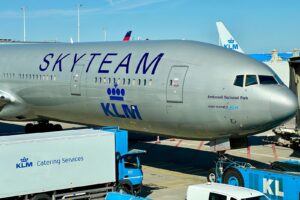After a summer of sky-high demand for international travel and premium cabins, the “Big Three” U.S. airlines — American Airlines, Delta Air Lines and United Airlines — all reported record profits.
Now, those airlines are hoping those trends are long-term.
Want more airline-specific news? Sign up for TPG’s free biweekly Aviation newsletter.
“Overseas, we think there’s just a lot more opportunity,” Andrew Nocella, United’s executive vice president and chief commercial officer, said at the Skift Aviation Forum in Fort Worth on Wednesday. “And, at the end of the day, it’s not that it’s just so amazing on average. It’s amazing when you have the seven gateways that United Airlines has.”
Nocella said he believed the U.S. market has matured due to having many different carriers operating in different markets. He added that he forecasted the industry’s domestic growth would be tied to the gross domestic product by the end of the decade, making it difficult for airlines to achieve high growth rates domestically.
American Airlines CEO Robert Isom shared a similar sentiment, saying that the Fort Worth-based carrier isn’t necessarily worried about an oversaturated transatlantic schedule next summer and pointing to its partnerships with Iberia and British Airways as part of the Oneworld alliance.
“A lot of our work is done in complement with those carriers, and we’re very mindful of what our hubs can support,” Isom said at the Skift Aviation Forum on Wednesday.
The Big Three airlines have doubled down on international demand and premium travel since the summer. United has added more routes to Asia and placed an order for 110 more long-haul jets.
Isom said American expects its premium-seating capacity to grow by approximately 45% by 2026 as it receives new deliveries of Boeing 787-9s and Airbus A321XLRs, starting in 2024. These deliveries are also a part of American’s plans to expand its presence in Europe for the summer 2024 travel season.
“I think customers view that as something that benefits them; they wanna have access to [it],” Isom said. “So we’re gonna be there with them.”
However, Robert Jordan, CEO at Southwest — the nation’s fourth big carrier — sang a slightly different tune.
Jordan offered a more cautious outlook on the high demand for international and premium travel, expressing skepticism on how long the travel trends will stick.
“We’ve seen patterns before. I’m not arguing that this won’t stick. But I am telling you, if you go back over the long history of the airline industry, there’s been a move to premium, there are seats in, seats out, seats in, seats out, as an example,” Jordan said at the Skift Aviation Forum, referring to what he believed was cyclical demand for premium seating.
Southwest reported strong profits during its second and third quarters but didn’t see the same soaring profits as the Big Three carriers. The Dallas-based carrier, which operates a low-cost business model, flew only domestic routes until 2014. In the decade since then, the airline has added routes to Mexico, Central America and the Caribbean, but it lacks premium seating and the sprawling international route networks that have buoyed American, Delta and United.
“There is no doubt that premium and, again, long-haul international are seeing outsized benefits today, just like domestic leisure was seeing an outsized benefit, 18 months, 12 months ago,” Jordan said. “We have continued to diversify our revenue significantly at Southwest Airlines.”
Jordan added that ancillary products, Southwest’s Rapid Rewards frequent flyer program and its cobranded credit cards have allowed the carrier to generate revenue at a faster pace than traditional seat growth. Southwest doesn’t have any business- or first-class cabins in its fleet — instead, the carrier structures fares around other perks like priority boarding and free inflight internet.
While it’s unclear how long passengers will want to shell out for first-class cabins or long-haul international flights, each airline executive believed their respective business models would work successfully in the long term.
The answer to what passengers really want likely will come soon enough. For now, though, look for the U.S. carriers to stick with what they believe is working.
Related reading:
- When is the best time to book flights for the cheapest airfare?
- The best airline credit cards
- What exactly are airline miles, anyway?
- 6 real-life strategies you can use when your flight is canceled or delayed
- Maximize your airfare: The best credit cards for booking flights
- The best credit cards to reach elite status
- What are points and miles worth? TPG’s monthly valuations


